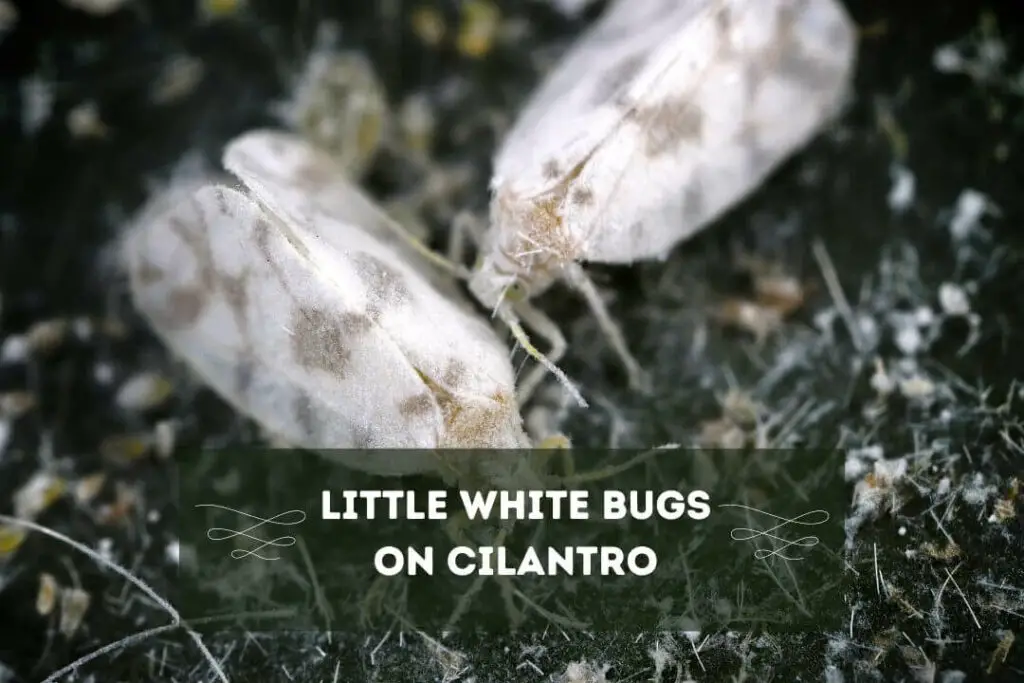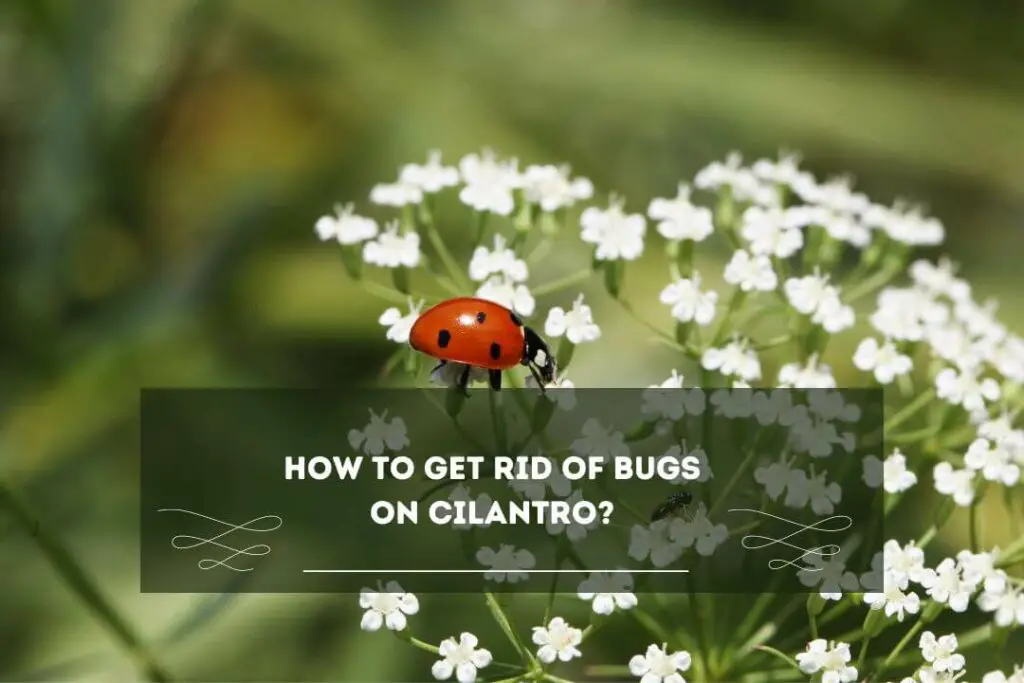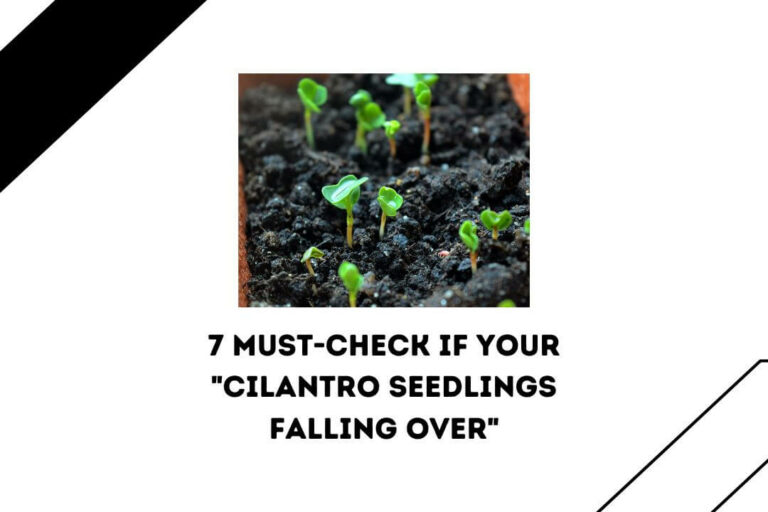You are right if you’re worried about tiny bugs crawling around on your cilantro plant. It is concerning to notice these pesky little critters crawling on your plant, as they can be a real nuisance that will damage beloved herbs.
This article will discuss three types of tiny bugs that commonly infest cilantro plants: aphids, spider mites, and whiteflies. We’ll cover how to identify them, signs of their presence, and the possible & practical treatment methods to eliminate them.
Whether you are already dealing with an infestation or want to be prepared for the future, this article will help you sport these tiny pests.
3 Tiny Bugs On Cilantro Plant

Little Black Bugs On Cilantro Plant “Aphids”

If you are not saying some little black bugs on your cilantro plant, maybe it is aphids. You should know that aphids are pesky little insects that love to feed on the sap of plants, including your cilantro.
Identifying these tiny insects that usually look dark brown or black is quite common. According to the University of Minnesota Extension, aphids are about 1/16 to 1/8 inch long and can come in different colors like green, yellow, brown, or black.
They usually have to pierce and suck mouthparts to extract sap from plants. You will find them clustered on your cilantro plant’s stems and leaves. If your cilantro plant is already suffering from this kind of pest, you might also notice sticky substances on your plant’s leaves.
Aphids also secrete a sticky substance called honeydew, which can attract other pests like ants. Therefore you need to take immediate action promptly because aphids can cause stunted growth and even death in severe cases.
You should know that aphids have also been noticed transmitting viruses & diseases to many plants, making your cilantro even more vulnerable to damage. Plantnatural says that aphids can send many plant viruses, including mosaic viruses that can cause irregular green and yellow patterns on plant leaves.
If the infestation is not severe, you can quickly treat it using natural methods. There are many types of treatment options available for aphids on cilantro plants.
Depending on the severity of the infestation, you can consider spraying your plant with a mixture of water & dish soap, which will eventually suffocate the aphids. Alternatively, you can introduce natural predators like ladybugs or lacewings to your garden, which will eat the aphids and keep their populations in check.
As per the University of California Agriculture and Natural Resources, parasitic wasps can also effectively control aphids. These wasps known for laying their eggs inside aphids, which later hatch and kill the host.
The University of Florida Extension also recommends to avoid using pesticides unless necessary. They can harm beneficial insects like bees and ladybugs which are essential for better yield & growth for your cilantro.
Tiny Green Bugs On Cilantro Plant

Sometimes, you notice little green bugs on cilantro plants, which could be spider mites. Spider mites are tiny little arachnids that love to feed on the sap of plants. According to the University of Illinois Urbana-Champaign, spider mites are about 1/50 inch long and can reproduce & lay 300 eggs over a week rapidly in hot, dry conditions.
Therefore, act as soon as possible before the infestation gets more severe. These tiny pests are usually green or yellow but can be very difficult to spot with the naked eye. They also love to hide and are often found on the undersides of cilantro leaves, where they feed on sap.
The most common signs of spider mites infestation, you are likely to see web’like structure, spot, and cilantro leaves yellowing, Browning, or curling. It can also be accompanied by stunted growth, which can even lead to death in severe cases.
Like aphids, spider mites can also transmit viruses and diseases to your plant if left untreated. Sin cilantro plants are already vulnerable to many pest infestations and conditions; you should consider using natural methods to get rid of these pesky bugs depending on the severity of the infestation.
As I told you earlier, it is better to use natural methods. Therefore, you should consider spraying your cilantro plant with water and neem oil, which will also suffocate the spider mites. It would be best to watch for signs of spider mites on your cilantro, which also includes webbing on the undersides of leaves to take action promptly.
Little White Bugs On Cilantro

Lastly, if you notice Little white bugs on cilantro plants, it will likely be whiteflies and nothing else. These tiny winged insects love to feed on the sap of plants that are usually white or yellow.
You can see them flying around your plant when disturbed. If you want to know whether your plant is suffering from these kinds of Little white bugs, you should check the underside of your cilantro plant leaves.
Whiteflies are often found on the undersides of leaves, where they feed on the sap and can cause the plant’s wilting, yellowing, or stunting. Whiteflies, like aphids, are about 1/16 inch long and are known for reproducing rapidly in warm weather conditions.
Like any other bugs, whiteflies can also cause severe damage to your plant, like transmitting viruses & diseases, reduced yield, stunted growth, and poor overall cilantro appearance if left untreated. You should know that white flies also attract other pests, like ants that love feeding on the honeydew secreted by the whiteflies.
How To Get Rid Of Bugs On Cilantro?

3 Natural Methods To Get Rid Of Bugs On Cilantro
Insecticidal Soap
I told you earlier you should be using a natural method to eliminate bugs. In this case, you can consider using insecticidal soap as these are usually made from potassium salts of fatty acid, which effectively control a wide range of insects, including those discussed in this article.
You should know that insecticidal soap will dissolve the protective outer layer of the pest, causing it to dehydrate and die. If you are considering using insecticidal soap, I recommend only mixing 122 tablespoons of soap in one quart of water.
After preparing it, spray it on the affected part of your cilantro plant. Ensure you cover both sides of your cilantro plant leaves and stems. If the infestation is severe, repeat the application every 7-20 days until all pests are gone.
Neem Oil
Alternatively, you can use name oil instead of insecticidal soap to eliminate pests and bugs. It is also another natural method that effectively removes bugs from cilantro plants. This type of oil is usually extracted from the neem tree seeds.
It contains all kinds of insecticidal properties needed to repel and kill pests, including aphids, spider mites, and whiteflies. As per experts, neem oil works by disrupting the feeding & mating habits of insects, ultimately leading to their demise.
If you want to use Neem oil instead of insecticidal soap, follow the same procedure. You need to mix one to two tablespoons of oil in one quart of water and then spray it on the affected area of your plant. As you did above, you need to repeat this process every 7 to 10 days and cover both sides of your plant leaves and stem until no bug is left.
Beneficial Insects
Lastly, you can introduce some predatory insects or beneficial insects to your cilantro plant Garden which is also an effective solution and natural method to get rid of bugs on cilantro.
Some of these insect types are known for either preying on the pest or parasitizing them, which helps reduce their populations. According to the University of California Agriculture and Natural Resources, beneficial insects effectively control pest populations and help maintain a healthy ecosystem in your garden.
Some common beneficial insects for controlling pest populations you can consider attracting to your garden are ladybugs, lacewings, and parasitic wasps. To attract this kind of beneficial insects around your cilantro plant, you should consider having as many flowers and herbs as possible in your garden, like dill, fennel, or marigold. Alternatively, you can purchase beneficial insects online and then release them in your garden for quick results. However, if you are growing dill with cilantro plants, you might get confused to differentiate between them. Many people often ask me why does my cilantro look like a dill?
Note: you can also use both need oil along with insecticidal soap to prepare a mix and pray it on your cilantro plant as it is considered to be the best cilantro bug repellent
Helpful Read: 5 EASY STEPS TO SAVE ‘OVERWATERED CILANTRO
Conclusion
In summary, I understand that dealing with bugs on cilantro plants is a challenging task, especially if you have mo previous experience with pest control and management. However, it is not impossible to treat with proper care and the right approach.
If you know the signs of different bugs, you can take the appropriate measures and implement natural methods to eliminate these infestations from your cilantro plant.
Make sure that you are taking reasonable precautions because prevention is critical. I recommend you regularly monitor your cilantro plant to spot any sign of infestation and take action immediately.
Believe it or not, knowing all this information will help you save a lot of time in the long run, especially if you take proper prevention and precaution with patience and perseverance.
I tried my best to give you all the information you needed about the types of tiny bugs on cilantro plants that you are likely to encounter and what you can do about it. If you find this article helpful, then consider sharing it.
Your share will help many people understand these little tiny bugs on cilantro plants and promptly act according to the type of infestation and its severity. Do check our other helpful guide on cilantro plant care and management. See you in the next post, till then, take care and goodbye.



![What Does Cilantro Look Like When It Sprouts? [Some Common Signs]](https://gardenthrone.com/wp-content/uploads/2022/10/what-does-Cilantro-look-like-when-it-sprouts-768x512.jpg)



